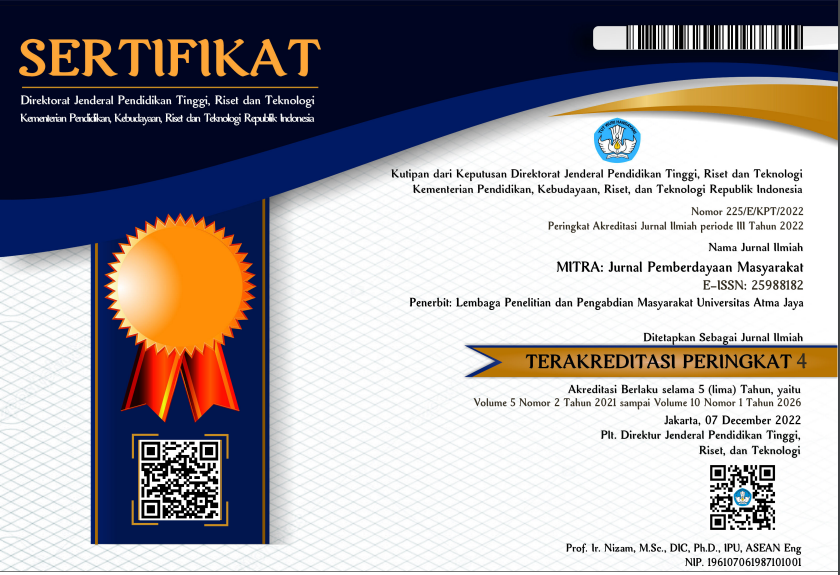Increasing the Quality of Gendola Fruit Syrup as a Healthy Drink
DOI:
https://doi.org/10.25170/mitra.v4i1.1066Keywords:
gendola fruit, encapsulation, syrupAbstract
Gendola herbal syrup is a solution in the form of syrup containing gendola as an active substance that is dissolved in the syrup component. Gendola syrup has a high betalain antioxidant content, and is beneficial for improving health. Betalain antioxidant content is easily damaged due to the influence of air, humidity, and temperature, causing the red color of the gendola to fade. The implementation of this project aimed to help improve the quality of Gendola syrup and provide training to partners so that they were able to market Gendola syrup products online. This project was implemented in productive community groups, UDHerba Puspitasari in Mlandangan Rt 02 Rw 08, Mandan Village, Sukoharjo District Sukoharjo Regency to make them able to produce and market herbal processed products. Based on observations of the results achieved, our partners were able to produce herbal syrup, although it was still limited, the quality was not good, and it did not yield profits. The methods implemented in this program included: 1) provide training for making Gendola syrup with encapsulation methods; 2) provide equipment that can support the production process; 3) provide online marketing training. The results obtained in this community-service activity contributed siqnificantly to UD Herba Puspitasari in their efforts of producing high-quality Gendola syrup and marketing the products online.
References
Bamidelle, O., Akinnuga, A. M., Olorunfemi, J. O., Odetola, O. A., Oparaji, C. K., & Ezeigbo, N. (2010). Effects of aqueous extract of Basella alba leaves on haematological and biochemical parameters in albino rats. African Journal of Biotechnology, 9(41), 6952-6955.
Chaitanya & Khrisna. (2012). Anti inflamatory activity of Basella alba Linn in albino rats. Journal Applied Pharm Sci, 65, 72-80.
Forgiarini, A., Esquena, J., Gonzalez, C., & Solans, C. (2001). Formation of nanoemulsions by low-energy emulsification methods at constant temperature. Langmuir, 17(7), 2076–2083.
Nirmala, A., Saroja, S., & Gayathri, S. (2011). Phytochemical screening and antihyperglycemic activity of Basella rubra. Recent Research in Science and Technology, 3(11), 80-83.
Otálora, M. C., Carriazo, J. G., Iturriaga, L., Nazareno, M. A., & Osorio, C. (2015). Microencapsulation of betalains obtained from cactus fruit (Opuntia ficus-indica) by spray drying using cactus cladode mucilage and maltodextrin as encapsulating agents. Food Chemistry, 187, 174-181.
Susilowati, D., & Mitha, P. M. (2009). Aktivitas antibakteri ekstrak n-heksana, etil asetat, etanol 70% daun binahong (Anredera cordofolia) terhadap pseudomonas aureginosa ATCC27853. Jurnal Farmasi Indonesia, 6(3), 19-24.
Voight, R. (1995). Buku pelajaran teknologi farmasi. Edisi V (Soendoro Noerono, Penerjemah.). Yogyakarta: Gadjah Mada University Press.
Downloads
Published
Issue
Section
License
This license allows reusers to distribute, remix, adapt, and build upon the material in any medium or format for noncommercial purposes only, and only so long as attribution is given to the creator. If you remix, adapt, or build upon the material, you must license the modified material under identical terms.



_.jpeg)

.png)
2.png)
.png)
.png)



